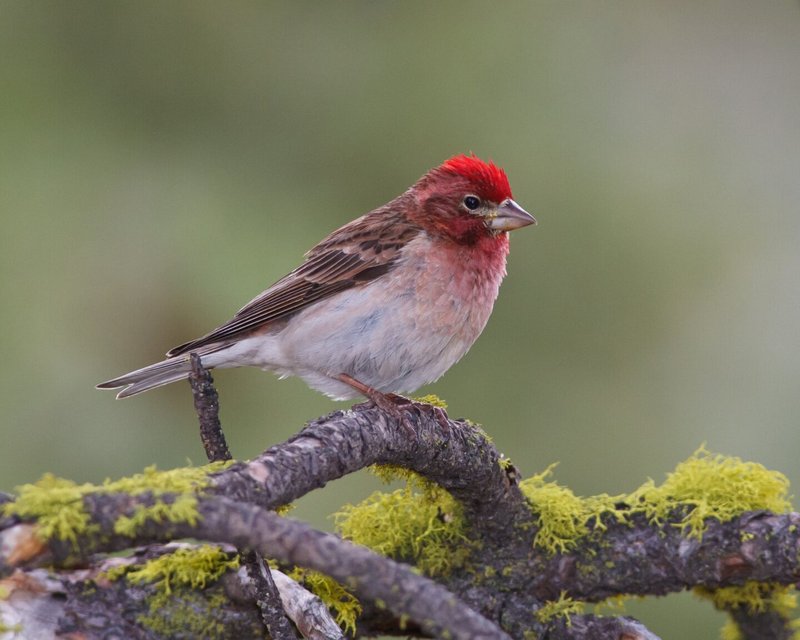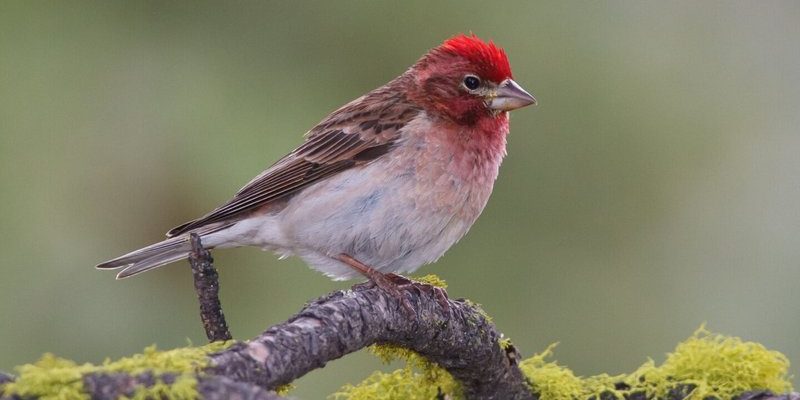
Have you ever heard a bird that sounds like a melody wrapped in sunshine? That’s the charm of the Cassin’s Finch. Found mostly in the mountainous regions of western North America, these little gems are not just about their beautiful tunes; they have some fascinating traits that make them stand out in the avian world. Imagine strolling through a pine forest, and as you pause to take in the surroundings, a Cassin’s Finch flutters by, bright and cheerful, bringing a splash of color and song to the quiet woods.
Named after ornithologist John Cassin, the Cassin’s Finch is a true symbol of the wild. Their vibrant plumage and distinctive songs have captured the hearts of birdwatchers and casual nature lovers alike. You might be wondering what makes these birds so special and how they differ from other finches you might encounter. Let’s dive into their world and explore their habits, habitat, and unique characteristics.
Physical Description
The Cassin’s Finch is a small to medium-sized bird, typically measuring around 6 to 7 inches in length. They have a chunky build with a short, thick bill that’s perfect for cracking seeds. Males are especially striking, showcasing a rich, rosy red crown and breast, which contrasts beautifully with their brown back and wings. Females, on the other hand, are more muted in color, featuring brown streaks and a less vibrant plumage.
What catches your eye first is that splash of red on the male. It’s like they’re wearing a little red badge of honor. This striking coloration is not just for show; it plays a vital role in attracting mates. During the breeding season, the male’s vivid colors can help him stand out in a crowd, making him more appealing to potential partners.
Key Features
Here’s a quick look at some interesting features of the Cassin’s Finch:
| Size: | 6 – 7 inches in length |
| Wingspan: | 10 – 11 inches |
| Weight: | 0.75 – 1 ounce |
| Coloration: | Rosy red (males), brown streaked (females) |
| Habitat: | Mountainous regions, coniferous forests |
| Diet: | Seeds, berries, insects |
| Lifespan: | Up to 6 years in the wild |
Habitat and Distribution
The Cassin’s Finch is primarily found in the western United States, especially in the mountainous areas of the Sierra Nevada, Rocky Mountains, and parts of Canada. These birds prefer coniferous forests and high-altitude meadows where they can find plenty of food. They thrive in areas with a mix of trees and open spaces, which support their feeding habits and nesting preferences.
During the winter months, you might see them venture into lower elevations. This seasonal migration allows them to find food sources more easily when snow blankets their typical habitats. Imagine witnessing their journey; it’s like watching little feathered nomads moving to warmer climates as seasons change.
Nesting Behavior
When it comes time to nest, Cassin’s Finches tend to choose spots that provide good cover. They typically build their nests in trees or shrubs, using materials like twigs, grass, and feathers to create a cozy environment. It’s interesting how their nests often blend into the surroundings, making them harder to spot—nature’s little camouflage!
Diet and Feeding Habits
Cassin’s Finches are primarily seed eaters, but their diet is quite varied. Their favorites include seeds from conifers, such as pine or spruce, and they also enjoy eating berries during the warmer months. Sometimes, they even dabble in insects, especially when feeding their young. Think of them as little foragers, always on the lookout for the next tasty treat.
They have a unique way of feeding. You might notice them perched on the ends of branches, where they can easily access seed cones or berries. Their short, thick bills are perfect for cracking open seeds, allowing them to easily access the nutritious morsels inside. It’s almost like they have their own little toolkit for dining!
Behavior and Social Structure
Cassin’s Finches are social birds and are often seen in flocks, especially in the winter months. They communicate with a series of cheerful chirps and whistles, creating a symphony as they flit about. Their social interactions are rich, and you might catch them engaging in playful behaviors with each other, such as chasing or preening. These interactions strengthen their bonds and help them stay connected in their tight-knit flocks.
Breeding and Reproduction
When it’s time to breed, male Cassin’s Finches go all out. They’ll sing beautifully to attract females, showcasing their vocal talents. Once a pair forms, they work together to build their nest. The female typically lays 3 to 5 eggs, which she will incubate for about two weeks. During this time, the male will help provide food to the female, showcasing the teamwork present in their relationships.
After the chicks hatch, they rely heavily on their parents for food. It’s a busy time for the adults as they dart back and forth, delivering seeds and insects to their hungry brood. You might find it heartwarming to think of the small family working together, ensuring that all chicks get the nourishment they need to grow strong.
Conservation Status
The Cassin’s Finch is currently not considered endangered, but like many species, they face challenges from habitat loss and climate change. Protecting their natural habitats is essential for their survival, ensuring these beautiful birds continue to thrive in the wild. There are many ways you can help, such as supporting local conservation efforts and protecting green spaces.
Unique Characteristics and Fun Facts
Cassin’s Finches have some fascinating quirks that make them truly unique. For example, did you know that they sometimes engage in “anting”? This behavior involves rubbing ants on their feathers, possibly to help rid themselves of parasites. It’s a bit like a spa day for these feathered friends!
Another fun fact is that Cassin’s Finches have a varied repertoire of songs. Their melodies can change depending on the time of year and the environment they find themselves in. It’s almost like they’re musicians responding to their surroundings with beautiful tunes.
Interaction with Humans
Birdwatchers and nature enthusiasts love spotting Cassin’s Finches due to their vibrant colors and cheerful songs. They often visit bird feeders when food is plentiful, providing a wonderful opportunity for people to appreciate their beauty up close. Having a feeder stocked with high-quality seeds can attract these finches to your backyard, allowing for some delightful birdwatching.
FAQ
What is the Cassin’s Finch’s primary diet?
The Cassin’s Finch primarily eats seeds. They thrive on seeds from conifers like pine, but they also enjoy berries and, occasionally, insects. This varied diet allows them to adapt to different habitats and food availability throughout the seasons.
Where can I find Cassin’s Finches?
You can find Cassin’s Finches in the western United States and parts of Canada, particularly in mountainous regions. They prefer coniferous forests and sometimes venture into lower elevations during the winter months. If you’re hiking in these areas, keep an eye out for their cheerful songs and vibrant colors!
Are Cassin’s Finches migratory?
While Cassin’s Finches are not strictly migratory, they do move to lower elevations during the winter months to find food. In the spring, they return to their high-altitude breeding grounds. This behavior helps them cope with changing food availability and harsh weather conditions.
How long do Cassin’s Finches typically live?
In the wild, Cassin’s Finches can live up to 6 years, although many face challenges that may reduce their lifespan. The combination of environmental factors, food availability, and predation can all influence how long these birds live.
What does the Cassin’s Finch’s song sound like?
The song of the Cassin’s Finch is a melodious series of chirps and whistles that can vary significantly from one bird to another. Males are often more vocal, especially during the breeding season, as they try to attract females. Their songs are pleasing and can brighten any forest setting!
Do Cassin’s Finches engage in courtship displays?
Yes, male Cassin’s Finches engage in various courtship displays to attract females. They often sing and may perform aerial displays while displaying their bright plumage. This behavior helps signal their fitness and suitability as a mate to potential partners.
What threats do Cassin’s Finches face?
Cassin’s Finches face several threats, including habitat loss due to logging, urban development, and climate change. Protecting their natural habitats is crucial for their survival, as these factors can significantly impact their population numbers and distribution.
How can I attract Cassin’s Finches to my garden?
To attract Cassin’s Finches to your garden, consider putting up a feeder stocked with high-quality seeds, especially sunflower and safflower seeds. They also appreciate native plants that produce seeds or berries. Providing water sources can further entice them to visit your backyard.
Are there any notable differences between male and female Cassin’s Finches?
Yes, there are noticeable differences between male and female Cassin’s Finches. Males are characterized by their bright rosy red coloration on their heads and chests, while females are more subdued, primarily brown and streaked. This difference in plumage serves as a way for males to attract mates during the breeding season.
What is the Cassin’s Finch’s role in the ecosystem?
Cassin’s Finches play an important role in their ecosystems as seed dispersers. By feeding on seeds and berries, they help in the growth of new plants by passing seeds through their digestive systems and distributing them in different areas. This contributes to biodiversity and helps maintain healthy ecosystems.

